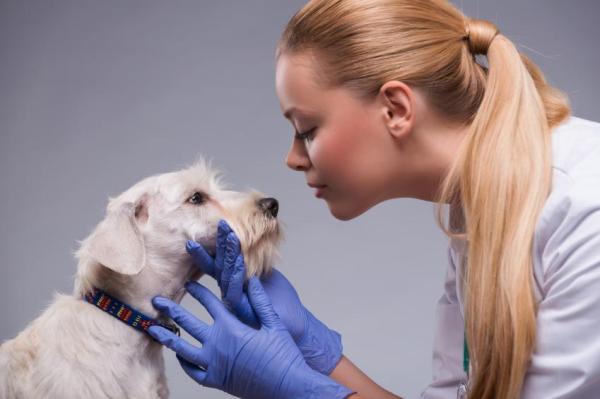
If you welcome a pet into your home, you should be aware that it is your responsibility as an owner to make sure your pet enjoys a full state of health and well-being. This is very important so that their body can function properly and they can live a long and happy life by your side.
Did you know that smell is the last sense to deteriorate in older dogs? Undoubtedly, a sense of smell is essential for dogs to interact with the environment properly, but this doesn't mean that other senses, such as vision, aren't important.
This AnimalWised article will talk about strabismus in dogs, a disorder that affects your pet's vision, as well as discuss its possible causes, symptoms and treatment.
What is strabismus?
There are very few diseases exclusive to humans, and strabismus is one of those conditions.
Strabismus is defined as a disorder of the coordination of the eyeball. When one suffers from strabismus, the eyes do not simultaneously look towards the same object. Dogs can suffer various types of strabismus:
- Esotropia: Eyes turn outwards
- Exotropia: Eyes turn is inwards
- Hypertropia: Eyes turn upwards
- Hypotropia: Eyes turn is downwards
Esotropia and exotropia affect both eyes, but hypertropia and hypotropia may affect one eyeball or both. This condition is commonly known as a squint.

What causes strabismus in dogs?
Two main causes can be distinguished which are responsible for canine strabismus:
- Congenital causes: In this case, the dog is born with the disorder due to an alteration produced in the extraocular muscles. The pug is a breed predisposed to congenital strabismus.
- Acquired causes: Strabismus occurs during the course of the dog's life. In this case, strabismus may be due to trauma, tumors, nervous disorders affecting the extraocular muscles or vestibular system disorders.
How do you detect strabismus in dogs?
The main symptom that you will see in a dog with strabismus is that the eyes do not look in the same direction. Therefore, it is an easily detectable disease. Sometimes when strabismus is caused by another disease you will also notice lethargy and decreased appetite.
Treating strabismus in dogs
When strabismus is the secondary cause of another disease, treatment should aim to eliminate the underlying alteration. In other cases, treatment is not usually required because the patient can have a completely normal life.
However, when the visual alteration is severe or when strabismus is acquired and not congenital, surgical intervention is the best option.

You may also like...
If you want to find out more about dog health and well-being, we recommend you check the following article on which dogs are the fastest?
This article is purely informative. AnimalWised does not have the authority to prescribe any veterinary treatment or create a diagnosis. We invite you to take your pet to the veterinarian if they are suffering from any condition or pain.
If you want to read similar articles to Strabismus in Dogs - Causes, Symptoms and Treatment, we recommend you visit our Other health problems category.